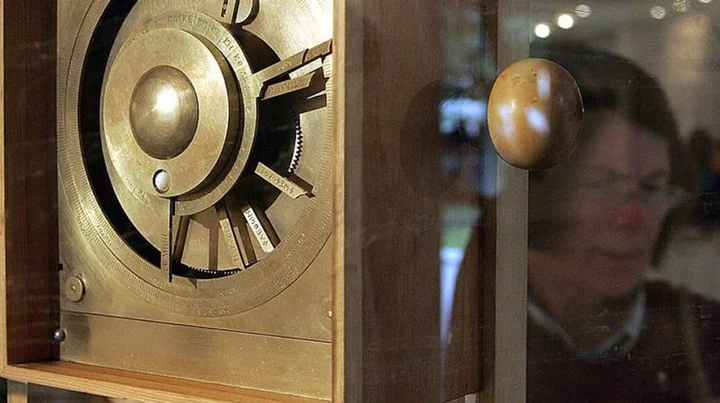
‘Monster stars’ 10,000 times bigger than the Sun detected for first time
Scientists have been peering into the depths of space, looking right back at the early days of the universe, and they’ve found something very interesting indeed. Researchers using the James Webb Space Telescope have come across a discovery that indicates some of the very earliest stars to ever form in the universe were staggering in scale, measuring 10,000 times bigger than the Sun. "Today, thanks to the data collected by the James-Webb Space Telescope, we believe we have found a first clue of the presence of these extraordinary stars," says astrophysicist Corinne Charbonnel of the University of Geneva in Switzerland, in research published in Astronomy & Astrophysics. These features are huge collections of between 100,000 and 1 million stars known as globular clusters, which all feature similar properties. Scientists estimate that they were all formed at the same time. Sign up to our free Indy100 weekly newsletter They’re remnants of the ancient universe and have been described by researchers as "fossils". The cores of these stars are much hotter than those we see in stars today, and scientists suggest it could be down to an excess of hydrogen burning at high temperatures. It’s thought that smaller stars collided with the supermassive stars and relished their energy. However, now most of these global clusters are approaching the very end of their life spans. "Globular clusters are between 10 and 13 billion years old, whereas the maximum lifespan of superstars is two million years," said Mark Gieles, previously at the University of Surrey but now at the University of Barcelona, back in 2018. "They therefore disappeared very early from the clusters that are currently observable. Only indirect traces remain." The researcher states: "If the supermassive star scenario can be firmed up by future studies, this would provide an important step for our understanding of globular clusters and for the formation of supermassive stars in general, with numerous important implications.” Have your say in our news democracy. Click the upvote icon at the top of the page to help raise this article through the indy100 rankings.
2023-05-26 23:22

Twitter debuts a mid-tier data access plan, to almost immediate backlash
Twitter unveiled a new data access tier on Thursday aimed at attracting startups, after its decision to erect a paywall for developers and researchers prompted widespread backlash. But the new tier already has some describing it as "too little, too late."
2023-05-26 22:49

Captcha is now asking users to identify objects that don't exist
Captcha is trying to get people using Discord a to identify objects that do not exist. As reported by Vice, multiple people using the platform are being shown a “Yoko,” which looks like a mix between a snail and a yoyo, and has been generated by AI, or other AI generated images like puzzle cubes. Meanwhile, two months ago, a Redditor noticed Discord was asking it to distinguish AI generated soccer players amidst a group of pictures of people playing hockey and golf. Sign up to our free Indy100 weekly newsletter Others have complained that images being generated are just 'awful.' Discord’s captchas are run by a company called hCaptcha. “The technology that generates these prompts is proprietary to our third-party partner and Discord does not directly determine what is presented to users,” Discord told Motherboard. “While most hCaptcha interactions do not result in a visual challenge, many variants are used at any given time. “This particular question was a brief test seen by a small number of people, but the sheer scale of hCaptcha (hundreds of millions of users) means that when even a few folks are surprised by a challenge this often produces some tweets.” Have your say in our news democracy. Click the upvote icon at the top of the page to help raise this article through the indy100 rankings.
2023-05-26 22:28

Discovery of '2000-year-old computer' leaves scientists baffled
Scientists have been left baffled by the discovery of the wreck of a 2,000-year-old “computer” that is amazingly complex. The Antikythera mechanism – an astronomical calendar – has been dubbed “‘the first computer” and has baffled scientists for generations after it was first discovered inside a Greek shipwreck in 1901. The device is a hand-powered time-keeping instrument that used a wing-up system to track the sun, moon and planets’ celestial time. It also worked as a calendar, tracking the phases of the Moon and the timing of eclipses. Despite sounding relatively simple, the mechanism was actually ahead of its time, being more technically sophisticated than any other tool that was invented over the next 1,000 years. In its current condition, the mechanism is in 82 separate fragments with only a third of its original structure remaining, including 30 corroded bronze gearwheels. Sign up to our free Indy100 weekly newsletter Research into the device from experts at University College London involved 3D computer modelling and helped them solve the mystery of how the device worked, revealing a “creation of genius”. Adam Wojcik, a materials scientist at UCL said at the time: “We believe that our reconstruction fits all the evidence that scientists have gleaned from the extant remains to date.” They theorised that the device tracked the movement of the sun, moon and planets on concentric rings, as the ancient Greeks believed that the sun and planets revolved around Earth, rather than the sun. The researchers explained in Scientific Reports: “Solving this complex 3D puzzle reveals a creation of genius—combining cycles from Babylonian astronomy, mathematics from Plato’s Academy and ancient Greek astronomical theories.” Have your say in our news democracy. Click the upvote icon at the top of the page to help raise this article through the indy100 rankings.
2023-05-26 20:45

8 Historic National Park Hotels for Your Bucket List
From a 175-year-old farmhouse to a luxury lodge on the Grand Canyon, these are the most historic places to stay in eight national park properties.
2023-05-26 20:22

French Drugmaker Weighs Bids For Scottish Site Behind Covid Debacle
Valneva SE has been approached by about a dozen potential buyers for its Scottish manufacturing site, according to
2023-05-26 19:53

Court says Hugh Grant's lawsuit alleging illegal snooping by The Sun tabloid can go to trial
A London court has rejected an attempt by the publisher of The Sun newspaper to throw out a lawsuit by actor Hugh Grant alleging that journalists and investigators it hired illegally snooped on him
2023-05-26 19:20

Cognizant's $570 million trade-secret case win against Syntel thrown out on appeal
By Blake Brittain A U.S. appeals court on Thursday vacated a $570 million award Cognizant Technology Solutions Corp
2023-05-26 18:49

Man suffers 'triple penis fracture after hearing a 'snap' during sex
One unlucky guy lived out every man’s worst nightmare recently, after suffering a “triple penis fracture”. A man from Tanzania was hospitalised after hearing his penis “snap” during sex. Details of the grisly injury were recorded in the International Journal of Surgery Case Reports. The “snap” happened “when the penis slipped out, lost the way” and struck his female partner “as he was trying to reinsert it”. It’s enough to make anyone wince, and the extent of his injury was revealed after he took himself to hospital. Sign up to our free Indy100 weekly newsletter Doctors took a look and found the penis to be severely swollen and covered in blood. They diagnosed him with having a “fractured” penis, which refers to a rupture in the fibrous connective tissue, called the tunica albuginea. Not only that, but an MRI scan also showed that there were three clear points of injury along the tunica albugine, with the main “fractures” in the erectile tissues known as the corpora cavernosa and the corpus spongiosum. The man was taken into surgery before being discharged three days later. He also had a catheter fitted in his urethra which was removed after three weeks. “He was seen at the clinic six months post-operative where he reported having resumed his sexual life with no any difficulties and the penile shaft looked OK,” his doctors said in the report. It sounds like all kinds of pain, and it’s an injury that is becoming more and more common. The NHS revealed stats in 2020 that showed 38 percent rise in such injuries from 2014 to 2020. Doctors speculated at the time that it could be down to pornography viewing habits leading to more couples trying unusual sexual positions, as well as an increase in the use of Viagra. Have your say in our news democracy. Click the upvote icon at the top of the page to help raise this article through the indy100 rankings.
2023-05-26 18:47

Dutch watchdog looking into alleged Tesla data breach
By Riham Alkousaa and Toby Sterling BERLIN/AMSTERDAM The data protection watchdog for the Netherlands said on Friday it
2023-05-26 18:46

UK competition regulator says Meta offers to limit use of ad data
UK's competition watchdog on Friday said social media giant Meta Platforms Inc had offered to limit the use
2023-05-26 18:28

Regulators take aim at AI to protect consumers and workers
As concerns grow over increasingly powerful artificial intelligence systems like ChatGPT, the nation’s financial watchdog says it’s working to ensure that companies follow the law when using AI
2023-05-26 17:24
